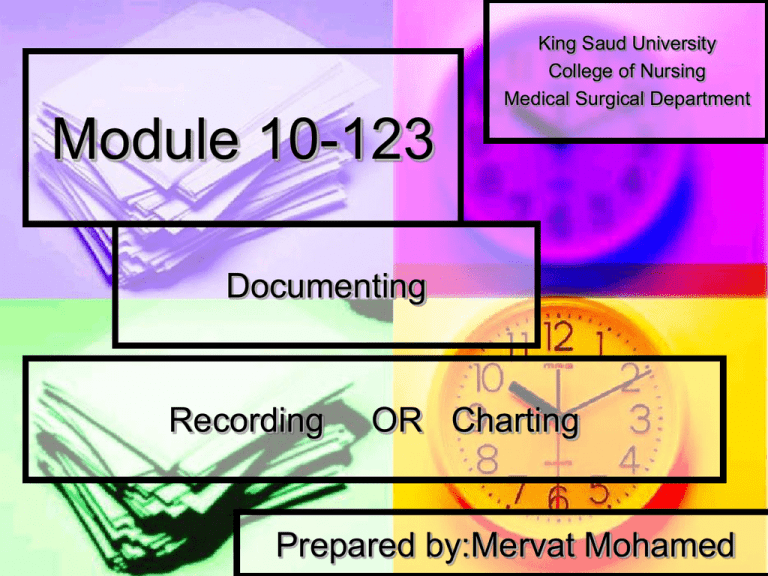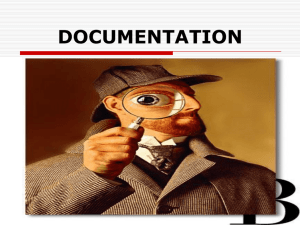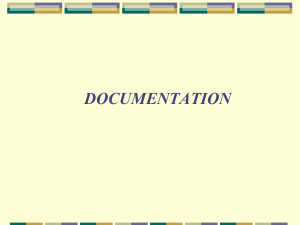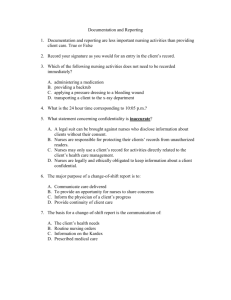Documentation123 - Home - KSU Faculty Member websites
advertisement

King Saud University College of Nursing Medical Surgical Department Module 10-123 Documenting Recording OR Charting Prepared by:Mervat Mohamed DOCUMENTING A report: is oral, written, or computer-based communication intended to convey information to others. For instance, nurses always report on clients at the end of a hospital work shift. DOCUMENTING A record: is written or computer-based. All personnel involved in a patient’s health care contribute to the medical record by charting, recording, or documenting (process of writing information) on the health agency’s forms. Medical record, also called a chart or client record, is a formal, legal document that provides information about a person’s health problems, the care provided by health practitioners, and the progress of the patient. Although health care organizations use different systems and forms for documentation, all client records have similar information. Documenting Purposes of client records A. B. C. D. Communication: patient’s record serves as the vehicle by which different members of the health team communicate and share information with each other. Assessment: nurses and other health team members gather assessment data from the patient’s record. Planning patient care: the entire health team uses data from the patient’s record to plan care for the patient. Education & research: nursing students, medical students and other health team members often use patient record as an educational tools. It provides a comprehensive view of the patient’s health status. The information contained in a record can be a valuable source of data for research. Documenting Purposes of client records E. Legal documentation: the client’s record is a legal document and is usually admissible in court as evidence. F. Health care analysis: records can be used to establish the costs of various services and to identify those services that cost the agency money and those that generate revenue. G. Auditing health agencies: patient’s record is used to monitor the care received by the patient and the competence of people giving that care. Documenting Types of Patient Records 1. Source-Orient Records: records organized according to the source of documented information. This type of record contains separate forms on which physicians, nurses, dietitians, physical therapists, and so on. One of the criticisms of source-oriented records is that it is difficult to demonstrate that there is a unified, cooperative approach for resolving the patient’s problems among caregivers. 2. Problem-Orient Records: records organized according to the patient’s health problems. Problemoriented records contain four major components: the data base, the problem list, the plan of care, and progress notes (Table 1). The information is arranged to emphasize goal-directed care, and to facilitate communication among health care professionals. Documenting Purposes of client records Component Description Database Contains initial health information Problem list Consists of a numeric of the patient’s health problems Plan of care Identifies methods for solving each identified health problem Progress notes describes the patient’s response to what has been done & revisions to the initial plan Table 1 common components of a problem-oriented record Documenting Methods of Charting 1. Narrative charting: Narrative charting (style of documentation generally used in source-oriented records) involves writing information about the patient and patient care in chronologic order. (Figure 1) Nursing Notes Date/time Nurses Remarks 13.30 pm States “I am having chest pain. It’s like an elephant is sitting on me” B. Zook, RN 13.40 pm Skin is pale & moist. O2 started at 5L/min Nitroglycerin tablet administered sublingual Figure 1 Sample of narrative charting Documenting Types of Patient Records 2. SOAP charting: SOAP charting (documentation style more likely to be used in a problem-oriented record) acquired its name from the four essential components included in a progress note: * S : subjective data * O : objective data * A : analysis of the data * P : plan for care SOAP charting helps to demonstrate interdisciplinary cooperation, because everyone involved in the care of a patient makes entries in the same location in the chart. (Table 2) Documenting Types of Patient Records Letter Explanation Nurses Remarks Subjective Information reported by the patient S - “Don’t feel well” Objective Information reported by the nurse O - Temperature 38C Analysis Problem identification A – Fever Plan Proposed treatment P – Increased fluid intake & Monitor body temperature Table 2 SOAP Charting format Documenting Types of Patient Records Focus charting: Focus charting (modified form of SOAP Charting) uses the word focus rather than problem, because some believe that the word problem carries negative connotations. Focus charting used DAR model: D = data category reflects the assessment phase of the nursing process A = action category reflects planning & implementation phase of the nursing process. R = response category reflect the evaluation of the nursing process (Figure 2). DAR notation tends to reflect the steps in the nursing process. Documenting Types of Patient Records 6/6/2006 10.15 am D (data) - Bladder distended 2 fingers above pubis Has not urinated since catheter was removed A (action) –Assisted to toilet. Water turned on at faucet R (response)- voided 525ml of clear urine L. Cass, SN Figure 2 Example of DAR charting Documenting Types of Patient Records 4. PIE charting: PIE charting is method of recording the patient’s progress under the headings of problem, intervention, and evaluation. When the PIE method is used, assessments are documented on separate form and the patient’s problems are given a corresponding number (Figure 3). Date/time Nurses Remarks 6/6 8.30 am P# 1 crackles heard on inspiration in the bases of R and L lungs. I# 1 splinted with pillow. Instructed to breathe deeply, open mouth, and cough at the end of expiration. E# 1 Lungs clear with coughing. L Cass, HN Figure 3 Sample of PIE charting Documenting Types of Patient Records 5. Computerized Charting: Computerized charting (documenting patient information electronically) is most useful for nurses when a terminal is available at the point of care or beside Documenting General Guidelines for Recording Because the client’s record is a legal document and may be used to provide evidence in court, many factors are considered in recording. 1. Data & Time: Documenting the date and time of each recording. This is essential not only for legal reasons but also for client safety. Record the time in the conventional manner (e.g. 9:00 am or 3:20 pm) or according to the 24-hours clock (military clock). 2. Timing: follow the agency’s policy about the frequency of documenting, and adjust the frequency as a client’s condition indicates; for example, a client whose blood pressure is changing requires more frequent documentation than a client whose blood pressure is constant. 3. Legibility: all entries must be legible and easy to read to prevent interpretation errors. Documenting General Guidelines for Recording 4. Performance: all entries on the client’s record are made in dark ink so that the record is permanent and changes can be identified. 5. Accepted Terminology: use only commonly accepted abbreviations, symbols, and terms that are specified by the agency. 6. Correct Spelling: correct spelling is essential for accuracy in recording. If unsure how to spell a word, look it up in a dictionary. 7. Signature: each recording on the nursing notes is signed by the nurse making it. The signature includes the name and title; for example, “Susan j. Green, RN” or “SJ Green, RN” 8. Sequence: documenting events in the order in which they occur; for example, record assessments, then the nursing interventions, and then the client’s responses. Documenting General Guidelines for Recording 9. Accuracy: the client’s name and identifying information should be written on each page of the clinical record. Accurate notations consist of facts or observations rather than opinions or interpretations. It is more accurate, for example, to write that the client “refused medication” (fact) than to write that the client “was uncooperative” (opinion) Good Luck





